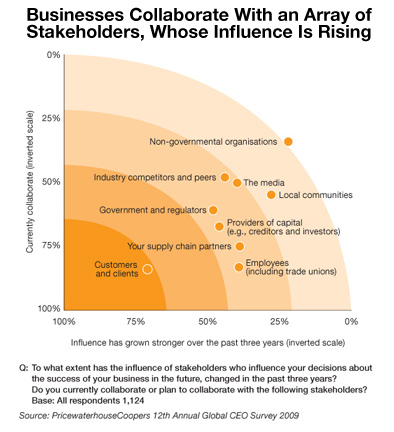The current financial crisis is a mixed bag for communications executives, according to a slew of recent industry reports. On the one hand, their value quotient seems to have increased exponentially in the eyes of CEOs, as suggested by Weber Shandwick, KRC Research and Spencer Stuart’s newest “Rising CCO” study. Among its findings: 58% of global chief communications officers (CCOs) now report to the CEO (as compared to 48% a year ago), and their average tenure has increased from 54 to 65 months.
On the other hand, the risk-saturated business environment presents a proliferating array of challenges to senior management teams. To overcome these challenges, business leaders are homing in on the most critical drivers of success: talent management, change management and the strength of the organization’s brand and reputation, which ranked first, second and third, respectively, in the 12th annual PricewaterhouseCoopers Global CEO Survey.
Seeing that list should prompt a unanimous response among communications execs: “Those are all part of my job.” Indeed, whether or not they are listed in the official job description, these responsibilities come naturally to communicators, which would explain the C-suite’s growing reliance on their skill sets.
“It goes without saying that CEOs and boards are under tremendous pressure to navigate through the stormy seas of the current economic tsunami,” according to Leslie Gaines-Ross, chief reputation strategist of Weber Shandwick. “Like never before, CEOs are depending on CCOs for crisis and issues counsel to steady their company reputations and calm stakeholders. CEOs who do not communicate using traditional and social media do so at their own peril.”
Thus, knowing the answers to the age-old question of “what keeps your CEO up at night?”—and, more important, knowing how to solve these causes of insomnia—is critical to further cementing communications into the strategy side of business.
CLOSING THE INFORMATION GAP
According to the PwC CEO survey, respondents believe that concrete information about their customers (94%), brand (91%) and employees (88%) are critical to long-term decision-making. That said, the percentages of CEOs who feel they have access to this information is staggeringly low:
• 21% have comprehensive info about the needs and preferences of customers;
• 31% have all the information they need about their corporate reputations; and,
• 30% have sufficient data about the views and needs of employees.
Given the increasing amount of collaboration required between organizations and stakeholders (see accompanying chart), this info deficit introduces significant risks, but it also marks an opportunity for communications execs to close this gap. After all, they should already be well-versed in metrics and should have access to data that can shape specific strategies surrounding:
• Customer loyalty: According to John Donahoe, CEO of eBay, his company uses a net promoter score for measuring customer loyalty. Building off of this type of analytics system, communications execs can use the data mined from their online interactions with customers, in turn painting a much clearer picture of customers’ pain points and preferences.
• Employee engagement: Partnering with HR puts communications in a strong position to measure levels of employee engagement, whether via hard metrics (surveys, pay-for-performance outcomes, etc.) or more qualitative insights (focus groups, participation in internal digital communications platforms, etc.).
• Reputation management: Measuring the value of corporate reputation is one of the proverbial (and clichéd) holy grails of communications, but emerging technologies have revolutionized the discipline’s capabilities. Whether you rely on Web analytics, measurement dashboards, media metrics or some combo of the above, you can offer unparalleled insight into the state of your company’s reputation.
 |
CLOSING THE TALENT GAP
Perhaps it’s not surprising that the war for talent remains a top concern for senior management, especially when it comes to the newest generation of employees. According to the CEO survey, 61% of respondents are having difficulty recruiting and integrating millennials into their workforce—something in which communications execs are very fluent, considering the increasingly prominent role social media plays in recruitment and retention efforts. But no matter the age range of employees, communicators can implement these best practices to help alleviate this pressure point:
• Segmentation: It may seem counterintuitive given the importance of fostering a cohesive corporate culture, but segmenting employees the way you would customers allows you to cater to different groups’ needs/preferences.
• Connection: Geographic distribution of workforces makes communications across an entire organization difficult, but digital platforms and emerging technologies—two specialties of communications execs—can help. Develop digital capabilities to train employees and help them connect with each other regardless of their location.
• Specialization: Centralized org structures once limited the degree to which business units could operate independently of one another. Now that communications and technology makes that less problematic, execs can focus on growing talent according to very specific customer needs. For example, the CEO of Securitas reports that he is moving “from a geographic organization to a customer-segment-oriented organization in order to increase the level of specialization.”
According to Léo Apotheker, co-CEO of SAP AG, “In a crisis, we are careful about hiring people, and we make sure the good ones stay with us.” PRN
CONTACT:
Leslie Gaines-Ross, [email protected]
